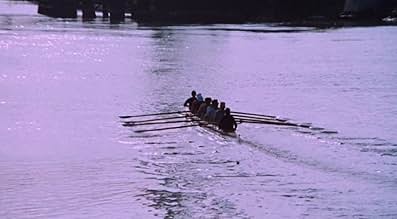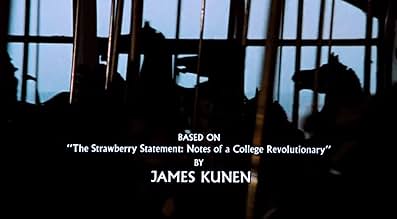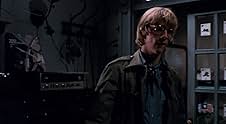NOTE IMDb
6,6/10
1,9 k
MA NOTE
Ajouter une intrigue dans votre langueAn apolitical college student joins a group of campus protesters to meet girls but gets swept up in their cause and involved in a violent confrontation with police.An apolitical college student joins a group of campus protesters to meet girls but gets swept up in their cause and involved in a violent confrontation with police.An apolitical college student joins a group of campus protesters to meet girls but gets swept up in their cause and involved in a violent confrontation with police.
- Réalisation
- Scénario
- Casting principal
- Récompenses
- 1 victoire et 2 nominations au total
Avis à la une
This movie will be of interest to anyone curious about the mores, attitudes, fashions, and lifestyles of the those involved in the radical student movement of the late 1960s. It presents a compelling portrait of the times. Personally I was left with the impression that the students were largely naive, spoiled idiots, and I found it difficult to sympathize with their agenda and methods. Nevertheless, I did feel for the duration of the movie that I was immersed in a reasonable, realistic representation of those times. The movie presents a more reality-based view of the late 60s than hippy freakout pieces like "Easy rider," for example, so you the viewer is advised to look at it as a kind of window into an era gone by.
Sorry, but it did. I read the book first, which was absolutely priceless. It was the journal of James Simon Kunen (called Simon in the movie), who was a jock at Columbia when the student uprising got started, and half-heartedly joined the protestors, mostly because the squares weren't meeting his needs. He had a wonderfully cynical, pessimistic attitude.
So what do they do for the movie? First they change the setting to San Francisco! Why? Then they make his character into a complete wimp; I cringed at almost every line. And they add all this gratuitous violence, despite the fact that there was almost no violence in the real-life uprising. What struck me about the book/journal was how disorganized everyone was. The protestors didn't have a clear plan. Some of the Columbia students opposed the protestors, and *they* didn't have a clear plan. The cops were powerless to do much of anything to the protestors except occasionally put handcuffs on them and herd them around, and the administration flipped back and forth constantly between trying to compromise with the students and threatening to expel everyone. What I got out of it was that revolution sounds like a great idea, until you get into the dean's office and realize that you don't know what to do, besides pose for a photo in his leather chair while holding a joint.
But that doesn't sell tickets. So they have a big, loud riot scene, ending with a totally campy freeze frame. (I was waiting for Bruce Davison to die in that manner when I saw him in X-Men! No such luck.)
So what do they do for the movie? First they change the setting to San Francisco! Why? Then they make his character into a complete wimp; I cringed at almost every line. And they add all this gratuitous violence, despite the fact that there was almost no violence in the real-life uprising. What struck me about the book/journal was how disorganized everyone was. The protestors didn't have a clear plan. Some of the Columbia students opposed the protestors, and *they* didn't have a clear plan. The cops were powerless to do much of anything to the protestors except occasionally put handcuffs on them and herd them around, and the administration flipped back and forth constantly between trying to compromise with the students and threatening to expel everyone. What I got out of it was that revolution sounds like a great idea, until you get into the dean's office and realize that you don't know what to do, besides pose for a photo in his leather chair while holding a joint.
But that doesn't sell tickets. So they have a big, loud riot scene, ending with a totally campy freeze frame. (I was waiting for Bruce Davison to die in that manner when I saw him in X-Men! No such luck.)
This exuberant, irreverent, tender, glorious film is THE cinematic embodiment of the sixties. This is one of the greatest films ever made. The camera work sparkles. Plot becomes almost irrelevant. This movie invented music video. It is much more than a movie about this or that. It is a celebration of life, youth, craziness, dreams. It leaves you yearning for life, and makes everything look beautiful. Watch this film to see how limited and timid most films are. What a breath of fresh air!!!!!
Those were the days.1968 had happened and the times they were changing.
A girl: "why didn't we protest before?
another girl: "we did not know."
"That time long ago when we thought our youth was eternal and the rebels were fighting in the mountains "
The story of a twenty-year old young man who worked hard to go to college and then discovers that the world he wants to get into is worthless.Like in the magnificent Joni Mitchell song (sung by Indian singer (and activist) Buffy Sainte -Marie which opens and closes the movie),Simon is "captive on the carousel of time ,where the little horses go up and down".His tiny apartment is a time capsule: the "2001:a space odyssey" soundtrack, a photograph of Robert Kennedy,and Neil Young's "down by the river" .
"The strawberry statement" could be subtitled "lost illusions ";the incident in the park was a real eye-opener;it's the failure of non-violence;that the "hero" should be "rewarded" for having been beaten up by the cops -whereas he was assaulted by one of his mates in the showers- clearly indicates that it's no use singing "give peace a chance" For those who lived through those troubled times and who did not realize they were "helpless" (like Neil Young sings in his classic also included in the soundtrack),"the strawberry statement" will remind them of that time when we could imagine that we were a brother hood of men and that strikes and songs and demonstrations could save the world.
Like this? try these....
"Alice's restaurant" by Arthur Penn
"Harold and Maud" by Hal Ashby(also featuring Bud Cort)
"Taking off" by Milos Forman
A girl: "why didn't we protest before?
another girl: "we did not know."
"That time long ago when we thought our youth was eternal and the rebels were fighting in the mountains "
The story of a twenty-year old young man who worked hard to go to college and then discovers that the world he wants to get into is worthless.Like in the magnificent Joni Mitchell song (sung by Indian singer (and activist) Buffy Sainte -Marie which opens and closes the movie),Simon is "captive on the carousel of time ,where the little horses go up and down".His tiny apartment is a time capsule: the "2001:a space odyssey" soundtrack, a photograph of Robert Kennedy,and Neil Young's "down by the river" .
"The strawberry statement" could be subtitled "lost illusions ";the incident in the park was a real eye-opener;it's the failure of non-violence;that the "hero" should be "rewarded" for having been beaten up by the cops -whereas he was assaulted by one of his mates in the showers- clearly indicates that it's no use singing "give peace a chance" For those who lived through those troubled times and who did not realize they were "helpless" (like Neil Young sings in his classic also included in the soundtrack),"the strawberry statement" will remind them of that time when we could imagine that we were a brother hood of men and that strikes and songs and demonstrations could save the world.
Like this? try these....
"Alice's restaurant" by Arthur Penn
"Harold and Maud" by Hal Ashby(also featuring Bud Cort)
"Taking off" by Milos Forman
Bruce Davison, Kim Darby, Bob Balaban, Bud Cort, that guy who looks like Bud Cort. They're all here along with some great music from Neil Young and others. The finale is powerful but some of the earlier stuff tries too hard to be trippy. The script is pretentious as well.
Le saviez-vous
- AnecdotesOriginally the film was to be shot on Columbia University's campus. However, Columbia withdrew their offer and the crew moved to Berkeley instead (Columbia University had already been through large student protests in 1967 and '68). The book had not gained notoriety yet and Berkeley was more or less in the dark about the content of the film and what events the director would be staging on the campus. This explains the tongue-in-cheek statement that appears before the opening credits thanking an "anonymous locale" and noting "other cities refused to cooperate."
- GaffesCoxswains don't say "stroke." The stroke of the boat (the rower in front of the coxswain) is responsible for maintaining the stroke rate.
- Citations
Girl in Filing Room: [after exposing her breasts to Simon] Did you know Lenin loved women with big breasts?
- Crédits fousThe following written statement appears on screen before the opening credits sequence: "The producers of this film gratefully acknowledge the cooperation of the people of San Francisco and another anonymous locale for participating in the production of this motion picture. Other cities refused to cooperate--perhaps feeling that strawberries are irrelevant."
- Versions alternativesThis movie has 2 cuts. A Theatrical release with 103 minutes and the International version that runs 109 minutes. Both version where included on the 2012 Warner DVD.
Meilleurs choix
Connectez-vous pour évaluer et suivre la liste de favoris afin de recevoir des recommandations personnalisées
- How long is The Strawberry Statement?Alimenté par Alexa
Détails
- Date de sortie
- Pays d’origine
- Langue
- Aussi connu sous le nom de
- The Strawberry Statement
- Lieux de tournage
- Stockton, Californie, États-Unis(city hall)
- Sociétés de production
- Voir plus de crédits d'entreprise sur IMDbPro
Box-office
- Budget
- 1 750 000 $US (estimé)
- Durée
- 1h 49min(109 min)
- Mixage
- Rapport de forme
- 1.85 : 1
Contribuer à cette page
Suggérer une modification ou ajouter du contenu manquant





























